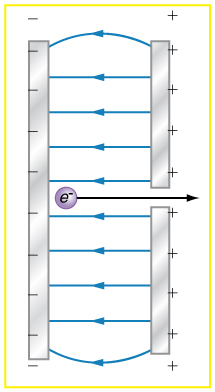| << Chapter < Page | Chapter >> Page > |
(a) What is the electric field 5.00 m from the center of the terminal of a Van de Graaff with a 3.00 mC charge, noting that the field is equivalent to that of a point charge at the center of the terminal? (b) At this distance, what force does the field exert on a charge on the Van de Graaff's belt?
(a) What is the direction and magnitude of an electric field that supports the weight of a free electron near the surface of Earth? (b) Discuss what the small value for this field implies regarding the relative strength of the gravitational and electrostatic forces.
(a)
(b)the coulomb force is extraordinarily stronger than gravity
A simple and common technique for accelerating electrons is shown in [link] , where there is a uniform electric field between two plates. Electrons are released, usually from a hot filament, near the negative plate, and there is a small hole in the positive plate that allows the electrons to continue moving. (a) Calculate the acceleration of the electron if the field strength is . (b) Explain why the electron will not be pulled back to the positive plate once it moves through the hole.

Earth has a net charge that produces an electric field of approximately 150 N/C downward at its surface. (a) What is the magnitude and sign of the excess charge, noting the electric field of a conducting sphere is equivalent to a point charge at its center? (b) What acceleration will the field produce on a free electron near Earth's surface? (c) What mass object with a single extra electron will have its weight supported by this field?
(a)
(b)
(c)
Point charges of and are placed 0.500 m apart. (a) At what point along the line between them is the electric field zero? (b) What is the electric field halfway between them?
What can you say about two charges and , if the electric field one-fourth of the way from to is zero?
The charge is 9 times greater than .
Integrated Concepts
Calculate the angular velocity of an electron orbiting a proton in the hydrogen atom, given the radius of the orbit is . You may assume that the proton is stationary and the centripetal force is supplied by Coulomb attraction.
Integrated Concepts
An electron has an initial velocity of in a uniform strength electric field. The field accelerates the electron in the direction opposite to its initial velocity. (a) What is the direction of the electric field? (b) How far does the electron travel before coming to rest? (c) How long does it take the electron to come to rest? (d) What is the electron's velocity when it returns to its starting point?

Notification Switch
Would you like to follow the 'College physics for ap® courses' conversation and receive update notifications?